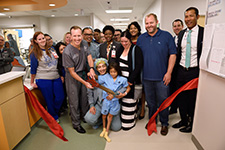I love this time of year – not simply because of the wonderful holiday spirit that surrounds us (although I do enjoy that too!). But I always appreciate the time to reflect on the year we’ve had. And this has been a year that tested our leadership, showcased our culture, and most of all, demonstrated our determination.
If you felt especially busy this year, it was not just a feeling, it is a fact. We had an incredible year that set records across the system, including:
- 33,659 surgeries
- 227,985 patient days
- 126,112 Emergency Center visits
- 87,242 Urgent Care encounters
- 438,501 Health Plan members
- 3.7 million patient encounters
I know this is a really busy time, and we may not even realize the tremendous work we have done as an organization over the past several months. So I want to share a few of the hallmarks of a pretty awesome year.
- Texas Children’s Hospital The Woodlands – Last Decemb
 er, we opened the Outpatient
er, we opened the Outpatient
Building at Texas Children’s Hospital The Woodlands, and we followed in April with the opening of inpatient services. There was an immediate response from the community. Within the five months remaining in fiscal year 2017, we had 991 admissions, 2,078 surgeries, 5,204 patient days and more than 12,000 EC visits. The families in North Houston were ready and waiting for Texas Children’s Hospital.
- Texas Children’s Hospital West Campus – Now in our seventh year, we continued to see strong growth and expansion at Texas Children’s Hospital West Campus. In FY2017, we had 3,707 admissions, 6,934 surgeries, 15,004 patient days and more than 43,000 EC visits. And can you believe we now have over 1,000 employees and more than 200 faculty at the West Campus? It’s just amazing.
- CareFirst – Our CareFirst initiative continues to unfold with our progress on Legacy Tower at our medical center campus. We celebrated our topping out of the tower in February, and we officially named it Legacy Tower in May. We’ve completed the exterior of the tower and the interiors of floors 8-10. Excitement is definitely building as we get closer to the May 2018 phase I opening. Also, as part of our CareFirst initiative, we opened Texas Children’s Mission Control in July. Located on the third floor of Texas Children’s Pavilion for Women, this suite is equipped with state-of-the-art technology and sharp employees from Room Management, Transport Services, Critical Care, Security and Facilities. The opening of Mission Control immediately improved the transfer process of our critically ill patients to and from Texas Children’s. Just months after the opening, we had reduced the time from dispatch to pick-up by 20 critical minutes.
- Texas Children’s Pavilion for Women – On March 26 we celebrated five years of delivering
 high quality and comprehensive care to women and newborns. In fiscal year 2017, we had 5,719 births and a 21% transfer rate to our NICU. The results at the Pavilion remind us what a sound strategy it was to move into the obstetrics space, giving us the ability to help secure our NICU volumes and, more importantly, to ensure the best possible outcomes for expectant mothers and their babies.
high quality and comprehensive care to women and newborns. In fiscal year 2017, we had 5,719 births and a 21% transfer rate to our NICU. The results at the Pavilion remind us what a sound strategy it was to move into the obstetrics space, giving us the ability to help secure our NICU volumes and, more importantly, to ensure the best possible outcomes for expectant mothers and their babies.
- Austin expansion – In May we announced our plans to expand our pediatric and OB/GYN services into Austin, beginning with the opening of a welcome center in January 2018, followed by a Texas Children’s Urgent Care clinic in March 2018 and a Texas Children’s Specialty Care practice in October 2018. Over the next five years, we plan to expand our network in Austin to include four pediatric urgent care clinics, 18 pediatric primary care practices, three pediatric specialty care locations and two maternal-fetal medicine practices.
- U.S. News rankings – The 2017 U.S. News and World Report Best Children’s Hospital
 rankings were announced in July, and Texas Children’s shined again. Eight of our pediatric subspecialties ranked in the top 10, and the other two are very close and steadily climbing. Perhaps most exciting this year was that we had another specialty to rise to the very top spot – Texas Children’s was ranked No. 1 in the nation in cardiology and heart surgery.
rankings were announced in July, and Texas Children’s shined again. Eight of our pediatric subspecialties ranked in the top 10, and the other two are very close and steadily climbing. Perhaps most exciting this year was that we had another specialty to rise to the very top spot – Texas Children’s was ranked No. 1 in the nation in cardiology and heart surgery.
- The Promise Campaign – We reached a significant milestone in Promise: The Campaign for Texas Children’s. By the end of September, donors had contributed $408.9 million, pushing the organization ever closer to its $475 million fundraising goal. The amount raised during fiscal year 2017 alone – $124.7 million – is a new annual high for the hospital’s fundraising team.
As much as I have shared above, there are still many more stories of triumph and resilience across Texas Children’s. Take a look at Texas Children’s Health Plan. We had a tough year, but we’re on the right path, and we’re responding to the tremendous needs of the children who depend on access to exceptional heath care. What we’re already seeing as a result of the challenges we faced this year with STAR Kids and in caring for a huge population for medically dependent children is that we’re learning quickly, right sizing appropriately, and we are thinking like a system. That bodes well for the Health Plan, and it makes for a healthier future for all of Texas Children’s.
Last, I would be completely remiss if I didn’t mention Hurricane Harvey. Together, we weathered this historical storm that devastated the Houston area, and together, we came out on the other side of it stronger. The resolve, determination and courage of our staff and employees were inspiring. I was simply in awe of you, and the way you supported each other, our patients and their families. It was a shining moment for us that showcased incredible strength and kindness.
And that was Texas Children’s in 12 months. Wow! It is quite a lot to reflect on and appreciate. With each passing year, we continue to get better and better. We take challenges, and we create opportunities. We encounter problems, and we recalibrate swiftly. And we prove time and again that we are one amazing team.
I’ll see you back here in 2018 for the next chapter of this remarkable story. Until then, happy holidays!


